This talk is part of the ResearchX session: The role of real-world data in tumor-agnostic drug development.
Sections include:
- Tumor site agnostic drug development: A genomics perspective
- Prevalence of TMB-H and association with survival in patients with less common solid tumors
- Characteristics and outcomes of real-world patients with MSI-H solid tumors treated with pembrolizumab
- Trends and challenges in tumor-agnostic drug development

Transcript
Chelsea Shao: Thank you, Olivier, for your introduction, and much appreciative of Flatiron organizers for their invitation. It's my great pleasure to present our tumor mutation burden, prevalence and prognostic study. This is truly a collaboration through Flatiron, Foundation Medicine and Merck. So thank you to all the colleagues who contributed to this great study. Next slide please.
This is my conflict of interest. I'm working in Merck. Next please. We all know that tumor mutation burden is an emerging clinical biomarker for response of immune checkpoint inhibitors. As you can see, from this bar graph, different tumor types, they have a different prevalence of a tumor mutation burden. And also you can see from the right hand at the plot, the higher tumor mutation burden associated with the higher overall response rates for immune checkpoint inhibitors in multiple variety clinical trials. Next please.
So the recent KEYNOTE-158 trial evaluated the TMB and outcomes after patients are treated with pembro monotherapy among these 10 tumor types as listed in this bar graph. You can see that for total populations, there are about 13% of patients that has a TMB-H across these 10 uncommon tumors and the objective response rate was 29% in the TMB-H group. However, only 6% in the non TMB-H group. However, there are limited real-world data on the prevalence of TMB across these uncommon 10 tumor types. Also very little data about the prognostic effects of the TMB across these tumor types, when the patients do not get treated with immunotherapy
Next slide please. So, for our studies, we have two main objectives. One is to evaluate the prevalence of TMB across these 10 tumor types from this real-world dataset. And another main objective is to look at the association between TMB and the real-world overall survival across these 10 tumor types who do not receive IO treatment. So for this study, we are using the Flatiron and the Foundation Medicine clinico-genomic dataset.
As you can see from the figure, the clinical data is coming from Flatiron data and linked with the genomic data, including the TMB measurements from Foundation Medicine. By July 2018, there are about 28,000 patients identified from this CGDB dataset. To be eligible for our study, we require the patients to be adult at the time of FMI report date and they had to have a valid TMB measurement. Also, they need to have one of the solid tumors from these 10 tumor types as listed below.
Next slide please. So for the TMB-H, we predefined that at least 10 mutation per megabase assessed by FMI. For all this analysis, we pre-specify them and for the primary populations we use the pan-tumor population. The patient who has confirmed the MSI-H cancers will [be] excluded from the primary analysis. However, we have the analysis in the sensitivity analysis including this MSI-H population. OS was analyzed by Kaplan-Meier method and also Cox Model was implicated. One thing to call out for this study, because we try to evaluate the TMB prognostic effects to eliminate the impact of IO treatments on the clinical outcomes, the patients with IO treatments were excluded if the start of the IO treatment is early or equal to the index date, and the patients who were censored if the start of IO day is after the index date.
Next slide please. So here is our high level results. Among these pan-tumor CGDB datasets, we identified about 2,600 patients who had the TMB measurements, and also had one of the 10 tumor types. These patients were included in the study. As you can see from the left hand table, this is the patient characteristic. You can see about 65% of patients were female. On average, the patients aged 64 years, and majority of today's patients come in from the community setting. And on average, there are about eight months follow up from the Foundation Medicine report date. If you see it from the pie chart, this is the distribution of the tumor types across this cohort. The top three tumor types are biliary, endometrial and also small cell lung cancer.
Next slide, please. So here is one of our main study results. When we use the 10 mutation per megabase as the TMB-H cut points, there are about 13% of patients who were TMB-H. As you can see from this bar graph, different tumor types, they have different TMB-H prevalence. Small cell lung cancer has a high TMB-H prevalence. And also mesothelioma has the lowest TMB prevalence. These data are very consistent with the KEYNOTE-158 findings and also consistent with the limited reports from the published papers. Next slide please.
So another important finding from this study is from the OS analysis. As you can see from the Kaplan–Meier curve showing at the right hand, those orange color represents the patients with non-TMB-H and the blue-ish color represents the patients with TMB-H group. So, from this analysis, we can see that patients with TMB-H have similar real-world overall survival compared to those patients with non-TMB-H tumors when they are not receiving IO treatment. The adjusted hazard ratio was 0.94. We adjusted for age, gender, cancer types, etc. Next please.
We also did a variety of different sensitivity analysis by looking at a different study population and to including or excluding MSI-H tumor patients and also using different index dates. So all of these sensitivity analysis is showing very consistent results. These are our primary analyses, as you can see from the forest plot, all of the 95 confidence interval cross one. Next please.
For this study, we conclude that the prevalence of TMB-H in this real-world dataset was about 13%. We used 10 mutation per megabase across the 10 uncommon tumors. And this prevalence varied across the tumor types. There was no association between TMB-H status and the real-world overall survival across these tumor types. These findings suggest that TMB-H do not have prognostic associations among these tumor types when they're not receiving IO treatment.
The studies suggest that the difference observed from the temporal trial across these 10 tumor types is likely coming from treatments and not necessarily coming from the TMB prognostic value. Next slide, please. So for this study, I like especially to thank our colleagues from different companies for their great contributions. This is an excellent collaboration. Thank you for your attention and the interest. Thanks.


